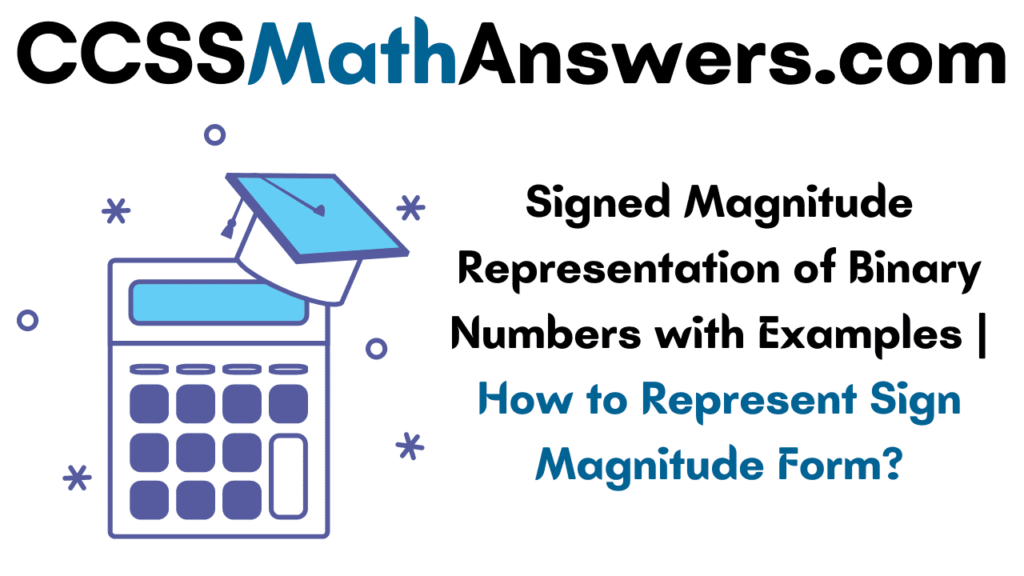In mathematics, every number has a sign. Negative numbers with any base are denoted by a prefix symbol ‘-‘. Binary numbers are the numbers that are expressed in base 2 having two symbols 0 and 1. Generally, the computer uses binary numbers. The sign of numbers in binary form is represented by the first binary digit in the number. Get the definition of signed magnitude representation and convert binary numbers into decimal and solved examples in the below sections. You can also find the difference between signed binary numbers and two’s complement numbers on this page.
Signed Magnitude Representation – Introduction
Every 8-bit binary number has magnitude and symbol which is used to indicate either the magnitude is positive or negative. The symbol defines the magnitude of the number. The sign bit is the left-most bit in the binary number. It is also known as the most significant bit. If the sign bit is 1, then it is a negative number, if the sign bit is 0, then it is a positive number.
The 8-bit binary numbers range from -127 to +127. To know the magnitude of the binary number, convert it into a decimal by following the below-mentioned rules and guidelines.
How to Convert Binary Numbers to Decimal Numbers?
Follow the below-listed steps to convert from a binary number to a decimal number. They are along the lines
- Let us take any 8-bit binary number.
- By checking the MSB digit, identify whether the number is positive or negative.
- Now, take the remaining 7 digits into consideration.
- Write the number 2 to the power 0 to n from the right side
- And multiply the 2 power number by the binary number
- Add all the terms to get the decimal number.
Also, Read:
Signed Magnitude Representation Examples
Example 1:
(10101011)2
Solution:
Given binary number is (10101011)2
The most significant digit is 1. So, the sign is negative
Decimal number = 26 x 0 + 25 x 1 + 24 x 0 + 23 x 1 + 22 x 0 + 21 x 1 + 20 x 1
= 64 x 0 + 32 x 1 + 16 x 0 + 8 x 1 + 4 x 0 + 2 x 1 + 1 x 1
= 32 + 8 + 2 + 1
= 43
Therefore, (10101011)2 = -(43)10
Example 2:
(01111111)2
Solution:
Given binary number is (01111111)2
The most significant digit is 0. So, the sign of the number is positive.
Decimal number = 26 x 1 + 25 x 1 + 24 x 1 + 23 x 1 + 22 x 1 + 21 x 1 + 20 x 1
= 64 x 1 + 32 x 1 + 16 x 1 + 8 x 1 + 4 x 1 + 2 x 1 + 1 x 1
= 64 + 32 + 16 + 8 + 4 + 2 + 1
= 127
Therefore, (01111111)2 = +(127)10
Example 3:
(01001101)2
Solution:
Given binary number is (01001101)2
The most significant digit is 0. So, the sign of the number is positive.
The decimal form of the number = 26 x 1 + 25 x 0 + 24 x 0 + 23 x 1 + 22 x 1 + 21 x 0 + 20 x 1
= 64 x 1 + 32 x 0 + 16 x 0 + 8 x 1 + 4 x 1 + 2 x 0 + 1 x 1
= 64 + 0 + 0 + 8 + 4 + 0 + 1
= 77
Therefore, (01001101)2 = +(77)10
Example 4:
(10010000)2
Solution:
Given binary number is (10010000)2
The most significant digit is 1. So, the sign is negative.
The decimal form of the number = 26 x 0 + 25 x 0 + 24 x 1 + 23 x 0 + 22 x 0 + 21 x 0 + 20 x 0
= 64 x 0 + 32 x 0 + 16 x 1 + 8 x 0 + 4 x 0 + 2 x 0 + 1 x 0
= 0 + 0 + 16 + 0 + 0 + 0 + 0
= 16
Therefore, (10010000)2 = -(16)10
FAQs on Signed Magnitude Representation
1. What is signed magnitude representation?
Sign and magnitude are two parts of a binary 8-bit number. The sign of numbers can be either positive or negative. The left-most digit of the number decides the sign of a decimal number. If the digit is 1, then negative sign, otherwise positive sign.
2. What is MSB?
MSB full form is the most significant bit. In a binary number, the bit at the left most corner is called the MSB, and the bit furthest to the right side is called the least significant bit.
3. Which digit in the binary number represents the sign?
The left-most digit in the binary number represents the sign of the decimal number. So, it is not included in the magnitude part of the number.
